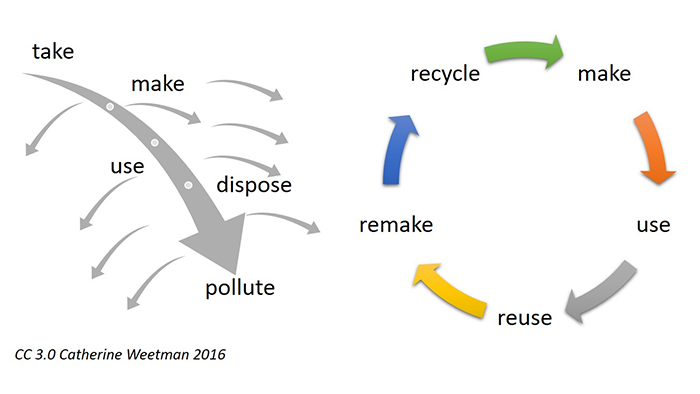What is Retail’s Role in the Circular Economy?
- 02/05/2019

Soul Searching
Brick and mortar isn’t going away anytime soon, but with a number of iconic store chains like Toys R Us, Brookstone, and Sears filing for bankruptcy, traditional retailers are doing some soul-searching. An important part of this search is considering how to benefit from the trend of shoppers looking for brands that elevate the shopping experience beyond a mere transaction, to infusing purpose and meaning into the interaction. Recent studies have shown that the trend of consumers willing to pay more for more sustainable products is largely driven by millennials and Gen Z consumers.Brands are finding that taking public stands can be positive, like the growth in Nike’s share price after signing Colin Kaepernick. Social and environmental product certifications continue to grow to fulfill the desire for consumers for greater discernment for who, what, and where they spend their money. One critical area where brick-and-mortar retailers have a clear advantage over.

Sustainability Through Circularity
The notion of circularity is as simple as turning a line into a circle. By bending the line of our current linear consumption systems into a more circular one, materials are able to cycle around at their highest and best use, rather than be landfilled or burned at their “end of life.” For example, for 5 years, TerraCycle, Colgate, and Shoprite have partnered to hold an annual Recycled Playground Challenge, where students across the eastern seaboard have a chance to win a playground made out of empty toothpaste tubes and floss containers for their school. Engaging customers at the end of a product’s life advances sustainability while creating opportunities for business development. Musical instrument string maker D’Addario connects with their customers through their Recycle and Restring Playback Program that helps move some of the 1.5 million pounds of old guitar and instrument strings from the landfill to a new use.Takeback initiatives open up possibilities for brands to connect with customers through the collection and recycling of end-of-use products or packaging. These programs can boost brand loyalty, win over new customers through reputational enhancement, and drive repeat purchases all because consumers who stop by to recycle an old item often stay to shop for other products. Some retailers choose to incentivize in-store recycling in exchange for a discount on a new product, like Target’s car-seat recycling promotion where customers redeemed 43,000 coupons in stores for new car-seats and more than 20,000 online.
Why Retail?
Why is retail critical for implementing a more circular economy and not cities and towns? One reason why municipalities are ill-equipped to handle many consumer items is that the material composition of consumer goods has exploded over the last couple of decades, while municipal recycling infrastructure has plateaued in the U.S. Materials recovery facilities (MRF) in America can still only handle uncoated paper, aluminum, sometimes glass and rigid plastic containers. In addition, municipalities are struggling with the sheer volume of recyclables, a situation made worse by China’s recent move to stop accepting much of the recyclable material – a move known as the “Green Fence.”While ‘circular economy’ may be a newer buzzword, the goal of having a more circular relationship with customers is nothing new. In fact, it’s called ‘return business’ and most business leaders know that it costs far less to retain existing customers than to attract new ones. This is the same thinking behind loyalty programs and customer engagement efforts.
Recycling and take back programs can be a direct and purpose-driven path to customer engagement. Brands like Kiehl’s, Subaru, and Staples have found that foot traffic increases, conversion rates grow, and average retail sales rise after launching in-store takeback programs. A growing list of retailers are getting ahead of their peers by providing this added service. For example, L’Occitane’s takeback program of recycling empties from all cosmetic brands has a 90% redemption rate for coupons handed out to customers, generating significant sales lifts through repeat purchases. Countless other examples exist of the stickiness of these programs, and the retailers leading the way on this critical issue receive direct financial gain as they position themselves as industry front runners by taking action and becoming part of the solution.
About the Author: Lisa Pellegrino takes great pride and joy in transforming waste streams into supply chains. She got her MBA in Sustainable Systems and works for TerraCycle, a triple bottom line company with the mission to eliminate the idea of waste. Lisa leads business development for the Zero Waste platform, a turnkey solution for recycling any hard-to-recycle product or packaging.
